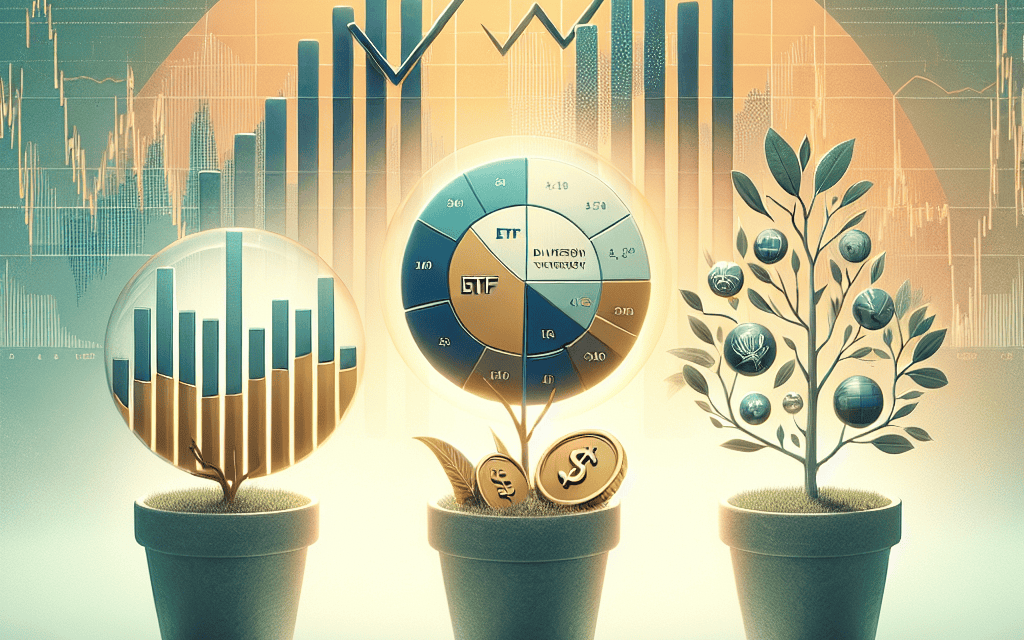“Secure Your Future: Invest in High-Yield Dividends and a Resilient ETF for a Decade of Growth.”
Introduction
Investing for the long term requires a strategic approach, focusing on assets that promise stability, growth, and reliable income over time. Among the myriad of investment options, high-yield dividend stocks and exchange-traded funds (ETFs) stand out as compelling choices for those seeking to build wealth steadily. This article delves into two high-yield dividend stocks and one ETF that are poised to deliver consistent returns over the next decade. These picks are not only backed by strong financial fundamentals but also by their potential to thrive in various market conditions, making them ideal candidates for a long-term investment portfolio. Whether you’re a seasoned investor or just starting, these selections offer a balanced mix of income and growth, ensuring your portfolio remains robust and resilient in the face of economic fluctuations.
Understanding High-Yield Dividend Stocks: A Long-Term Investment Strategy
Investing in high-yield dividend stocks and exchange-traded funds (ETFs) can be a prudent strategy for those seeking to build wealth over the long term. This approach not only provides a steady stream of income but also offers the potential for capital appreciation. As investors navigate the complexities of the financial markets, understanding the nuances of high-yield dividend stocks becomes essential. These stocks are typically issued by well-established companies with a history of stable earnings and a commitment to returning capital to shareholders. Consequently, they are often seen as a reliable source of income, especially in times of market volatility.
One of the top long-term picks in the realm of high-yield dividend stocks is Johnson & Johnson. Known for its diversified portfolio in the healthcare sector, Johnson & Johnson has consistently demonstrated its ability to generate robust cash flows. This financial strength enables the company to maintain and even increase its dividend payouts over time. Moreover, its strong brand reputation and innovative product pipeline provide a solid foundation for future growth. As a result, investors can expect not only a steady income stream but also potential capital gains as the company continues to expand its market presence.
Another compelling high-yield dividend stock is Procter & Gamble. As a leader in the consumer goods industry, Procter & Gamble boasts a wide array of well-known brands that enjoy significant market share. The company’s focus on innovation and efficiency has allowed it to maintain a competitive edge, even in challenging economic environments. Procter & Gamble’s commitment to returning value to shareholders is evident in its long history of dividend increases, making it an attractive option for those seeking a reliable income source. Furthermore, the company’s global reach and strong distribution networks position it well for sustained growth, providing investors with both income and potential appreciation.
In addition to individual stocks, ETFs can offer a diversified approach to high-yield investing. One such ETF that stands out is the Vanguard High Dividend Yield ETF. This fund seeks to track the performance of the FTSE High Dividend Yield Index, which comprises companies characterized by above-average dividend yields. By investing in this ETF, investors gain exposure to a broad range of high-quality dividend-paying companies across various sectors. This diversification helps mitigate the risks associated with individual stock investments while still providing the benefits of a high-yield strategy. Moreover, the ETF’s low expense ratio ensures that investors retain more of their returns, enhancing the overall appeal of this investment vehicle.
In conclusion, incorporating high-yield dividend stocks and ETFs into a long-term investment strategy can be a wise decision for those seeking both income and growth. Johnson & Johnson and Procter & Gamble exemplify the qualities of reliable dividend payers with strong growth prospects, while the Vanguard High Dividend Yield ETF offers a diversified approach to capturing high yields. As investors consider their options, it is crucial to evaluate the financial health and growth potential of these investments, ensuring they align with their long-term financial goals. By doing so, investors can build a resilient portfolio capable of weathering market fluctuations and delivering consistent returns over the next decade.
The Benefits of Holding Dividend Stocks for a Decade
Investing in dividend stocks and exchange-traded funds (ETFs) with a long-term perspective can be a rewarding strategy for those seeking both income and growth. Holding these investments for a decade or more allows investors to benefit from the power of compounding, potential capital appreciation, and a steady stream of income. In this context, two high-yield dividend stocks and one ETF stand out as top long-term picks, offering a blend of stability and growth potential.
Firstly, dividend stocks are particularly appealing due to their ability to provide consistent income through regular payouts. This income can be reinvested to purchase additional shares, thereby compounding returns over time. One such high-yield dividend stock is Johnson & Johnson (JNJ). Known for its diversified portfolio in the healthcare sector, Johnson & Johnson has a long history of paying and increasing dividends. Its robust financial health and commitment to innovation make it a reliable choice for long-term investors. Over a decade, the company’s consistent dividend growth can significantly enhance an investor’s total return, especially when dividends are reinvested.
In addition to individual stocks, ETFs offer a diversified approach to investing in dividend-paying companies. The Vanguard High Dividend Yield ETF (VYM) is an excellent example of an ETF that focuses on high-yield dividend stocks. By holding a broad range of companies across various sectors, VYM provides investors with exposure to a diversified portfolio, reducing the risk associated with individual stock investments. This ETF is designed to track the performance of the FTSE High Dividend Yield Index, which includes companies with above-average dividend yields. Over a ten-year period, the compounding effect of reinvested dividends, combined with potential capital appreciation, can lead to substantial growth in an investor’s portfolio.
Moreover, another high-yield dividend stock worth considering is Procter & Gamble (PG). As a leading consumer goods company, Procter & Gamble has a strong track record of delivering consistent dividends to its shareholders. The company’s diverse product portfolio, which includes well-known brands in categories such as personal care, cleaning, and health, provides a stable revenue stream. This stability, coupled with the company’s commitment to returning capital to shareholders, makes Procter & Gamble an attractive long-term investment. Over a decade, the company’s ability to adapt to changing consumer preferences and maintain its market leadership can contribute to sustained dividend growth and capital appreciation.
Furthermore, holding dividend stocks and ETFs for a decade allows investors to ride out market volatility and benefit from the long-term growth potential of these investments. During periods of market downturns, dividend payments can provide a cushion, offering a source of income even when stock prices are under pressure. This income can be particularly valuable for investors seeking to supplement their retirement savings or achieve financial independence.
In conclusion, the benefits of holding high-yield dividend stocks and ETFs for a decade are manifold. Johnson & Johnson and Procter & Gamble, with their strong financial positions and commitment to dividend growth, offer reliable income streams and potential for capital appreciation. Meanwhile, the Vanguard High Dividend Yield ETF provides diversification and exposure to a broad range of high-yield dividend stocks. By adopting a long-term perspective, investors can harness the power of compounding and enjoy the stability and growth potential that these investments offer.
Analyzing the Top High-Yield Dividend Stocks for Long-Term Growth
In the ever-evolving landscape of investment, identifying assets that promise both stability and growth over the long term is a crucial endeavor for investors. Among the myriad of options available, high-yield dividend stocks and exchange-traded funds (ETFs) stand out as particularly attractive for those seeking consistent income and potential capital appreciation. As we delve into the realm of long-term investment strategies, two high-yield dividend stocks and one ETF emerge as compelling choices for a decade-long hold, offering a blend of reliability and growth potential.
To begin with, high-yield dividend stocks are often favored by investors for their ability to provide a steady income stream, even during market downturns. One such stock that has consistently demonstrated resilience and growth is Johnson & Johnson. With a robust portfolio spanning pharmaceuticals, medical devices, and consumer health products, Johnson & Johnson has established itself as a leader in the healthcare sector. The company’s commitment to innovation and its strong pipeline of new products ensure a sustainable competitive advantage. Moreover, Johnson & Johnson’s impressive track record of dividend increases over the past several decades underscores its financial stability and commitment to returning value to shareholders. This makes it an ideal candidate for investors seeking both income and long-term growth.
Transitioning to another high-yield dividend stock, Realty Income Corporation presents a unique opportunity within the real estate investment trust (REIT) sector. Known as “The Monthly Dividend Company,” Realty Income has built a reputation for its consistent monthly dividend payments, which are supported by a diversified portfolio of over 6,500 properties across various industries. The company’s focus on high-quality tenants and long-term leases provides a stable revenue stream, while its strategic acquisitions and expansions offer growth potential. Realty Income’s disciplined approach to capital management and its commitment to maintaining a strong balance sheet further enhance its appeal as a long-term investment. For investors seeking a reliable income source with the potential for capital appreciation, Realty Income stands out as a prudent choice.
In addition to individual stocks, ETFs offer a diversified approach to investing, allowing investors to gain exposure to a broad range of assets with a single purchase. The Vanguard High Dividend Yield ETF is a prime example of an ETF that aligns with the goals of long-term investors. This ETF focuses on companies with above-average dividend yields, providing investors with a steady income stream while also offering the potential for capital growth. The fund’s diversified holdings across various sectors, including consumer goods, healthcare, and financials, mitigate risk and enhance stability. Furthermore, Vanguard’s reputation for low-cost management and efficient tracking of its benchmark index ensures that investors can maximize their returns over the long term.
In conclusion, the combination of high-yield dividend stocks and a well-chosen ETF can form the cornerstone of a successful long-term investment strategy. Johnson & Johnson and Realty Income Corporation offer compelling opportunities for income and growth, while the Vanguard High Dividend Yield ETF provides diversification and stability. By carefully selecting these assets and maintaining a long-term perspective, investors can position themselves to achieve their financial goals over the next decade. As always, it is essential to conduct thorough research and consider individual risk tolerance before making investment decisions.
How to Choose the Best ETF for a 10-Year Investment Horizon

When considering a 10-year investment horizon, selecting the right exchange-traded fund (ETF) can be a pivotal decision in achieving long-term financial goals. ETFs offer a diversified portfolio of assets, which can mitigate risk and provide steady returns over time. However, with the myriad of options available, choosing the best ETF requires careful consideration of several key factors.
Firstly, it is essential to evaluate the ETF’s underlying index or asset class. An investor should align their choice with their financial objectives and risk tolerance. For instance, if the goal is to achieve growth, an ETF that tracks a broad market index like the S&P 500 might be suitable. Conversely, if the focus is on income generation, an ETF that targets high-dividend stocks could be more appropriate. Understanding the composition of the ETF and the sectors it covers can provide insight into its potential performance over the long term.
Moreover, the expense ratio of an ETF is a critical factor to consider. This ratio represents the annual fee that investors pay to the fund manager, expressed as a percentage of the total assets. Lower expense ratios can significantly enhance returns over a decade, as they reduce the cost of investment. Therefore, comparing the expense ratios of similar ETFs can help identify the most cost-effective option.
Another important aspect is the historical performance of the ETF. While past performance is not indicative of future results, it can offer valuable insights into how the ETF has navigated different market conditions. Analyzing the ETF’s performance during market downturns and periods of volatility can reveal its resilience and potential stability over a long-term horizon. Additionally, examining the ETF’s tracking error, which measures how closely it follows its benchmark index, can indicate its efficiency and reliability.
Liquidity is also a crucial consideration when selecting an ETF for a 10-year investment. High liquidity ensures that the ETF can be easily bought or sold without significantly affecting its price. This is particularly important for long-term investors who may need to adjust their portfolios in response to changing financial circumstances or market conditions. ETFs with higher average daily trading volumes typically offer better liquidity.
Furthermore, the reputation and track record of the fund manager can influence the decision-making process. A well-established fund manager with a history of successful ETF management can provide confidence in the fund’s potential to meet its investment objectives. Researching the fund manager’s experience and expertise in managing similar funds can offer additional assurance.
Lastly, considering the tax implications of an ETF is vital for long-term investors. Some ETFs are structured to be more tax-efficient, which can enhance after-tax returns. Understanding the tax treatment of dividends and capital gains associated with the ETF can help investors make informed decisions that align with their tax strategies.
In conclusion, choosing the best ETF for a 10-year investment horizon involves a comprehensive evaluation of various factors, including the underlying index, expense ratio, historical performance, liquidity, fund manager reputation, and tax implications. By carefully considering these elements, investors can select an ETF that aligns with their financial goals and risk tolerance, ultimately positioning themselves for success over the long term.
Comparing Dividend Stocks and ETFs: Which is Better for Long-Term Gains?
When considering long-term investment strategies, the choice between dividend stocks and exchange-traded funds (ETFs) often arises. Both options offer unique advantages, and understanding these can help investors make informed decisions. Dividend stocks, particularly those with high yields, provide a steady income stream, which can be reinvested to compound returns over time. On the other hand, ETFs offer diversification and lower risk, making them appealing to those seeking stability. To illustrate the potential of these investment vehicles, we will explore two high-yield dividend stocks and one ETF that are poised for growth over the next decade.
Firstly, dividend stocks have long been favored by investors seeking regular income. Companies that consistently pay dividends often exhibit strong financial health and a commitment to returning value to shareholders. Among the top picks in this category is Johnson & Johnson (JNJ), a stalwart in the healthcare sector. Known for its robust product portfolio and global reach, Johnson & Johnson has a track record of increasing dividends for over 50 consecutive years. This consistency not only reflects the company’s resilience but also its ability to adapt to changing market dynamics. As healthcare continues to be a critical industry, Johnson & Johnson’s diversified operations in pharmaceuticals, medical devices, and consumer health products position it well for sustained growth.
Another compelling dividend stock is Procter & Gamble (PG), a leader in the consumer goods sector. With a diverse range of trusted brands, Procter & Gamble has demonstrated an ability to maintain strong cash flows and profitability. The company’s focus on innovation and efficiency has enabled it to navigate economic cycles effectively. Procter & Gamble’s commitment to returning capital to shareholders is evident in its long history of dividend payments, which have been consistently increased for over six decades. This reliability makes it an attractive option for investors seeking both income and capital appreciation over the long term.
While individual dividend stocks offer specific advantages, ETFs provide a different set of benefits that can enhance a long-term investment strategy. One notable ETF is the Vanguard Dividend Appreciation ETF (VIG), which focuses on companies with a history of increasing dividends. This ETF offers exposure to a broad range of sectors, reducing the risk associated with investing in individual stocks. By holding a diversified portfolio of dividend-paying companies, the Vanguard Dividend Appreciation ETF provides investors with a balanced approach to income and growth. Additionally, the ETF’s low expense ratio ensures that more of the investor’s capital is working for them, rather than being eroded by fees.
In comparing dividend stocks and ETFs, it is essential to consider one’s investment goals and risk tolerance. Dividend stocks like Johnson & Johnson and Procter & Gamble offer the potential for higher yields and individual company growth, but they also come with the risk of company-specific challenges. Conversely, ETFs like the Vanguard Dividend Appreciation ETF provide diversification and stability, which can mitigate some of these risks. Ultimately, a combination of both dividend stocks and ETFs may offer the best of both worlds, allowing investors to benefit from steady income and diversified growth.
In conclusion, the decision between dividend stocks and ETFs should be guided by an investor’s long-term objectives and financial situation. By carefully selecting high-quality dividend stocks and well-managed ETFs, investors can build a resilient portfolio capable of weathering market fluctuations and delivering consistent returns over the next decade.
The Role of Dividend Reinvestment in Maximizing Long-Term Returns
Dividend reinvestment plays a crucial role in maximizing long-term returns, particularly when it comes to high-yield dividend stocks and exchange-traded funds (ETFs). By reinvesting dividends, investors can harness the power of compounding, which significantly enhances the growth potential of their investments over time. This strategy involves using dividends received from stocks or ETFs to purchase additional shares, thereby increasing the investor’s holdings and potential future dividends. As a result, the investor benefits from an ever-growing income stream and capital appreciation, which can be particularly advantageous when holding investments for a decade or more.
To illustrate the impact of dividend reinvestment, consider two high-yield dividend stocks and one ETF that are well-suited for long-term investment. These selections not only offer attractive yields but also possess strong fundamentals and growth prospects, making them ideal candidates for a buy-and-hold strategy. The first stock is a leading utility company known for its stable cash flows and consistent dividend payments. Utility companies typically operate in regulated industries, providing essential services such as electricity and water. This stability allows them to generate reliable income, which they often return to shareholders in the form of dividends. By reinvesting these dividends, investors can gradually increase their ownership in the company, thereby enhancing their potential returns over the long term.
The second stock is a well-established real estate investment trust (REIT) that focuses on high-quality commercial properties. REITs are required by law to distribute a significant portion of their taxable income as dividends, making them attractive to income-focused investors. This particular REIT has a diversified portfolio of properties, which helps mitigate risks associated with economic downturns or sector-specific challenges. By reinvesting dividends from this REIT, investors can capitalize on the growth of the real estate market while benefiting from the compounding effect of their reinvested dividends.
In addition to individual stocks, ETFs offer a diversified approach to dividend investing. The selected ETF in this context tracks a broad index of high-yield dividend stocks, providing exposure to a wide range of sectors and industries. This diversification reduces the risk associated with investing in individual stocks while still offering the potential for attractive returns. By reinvesting dividends from the ETF, investors can take advantage of the growth of multiple companies, further enhancing their long-term returns.
Moreover, dividend reinvestment is a disciplined approach that encourages investors to remain committed to their investment strategy, even during periods of market volatility. By automatically reinvesting dividends, investors avoid the temptation to time the market or make impulsive decisions based on short-term fluctuations. This long-term perspective is essential for maximizing returns, as it allows investors to benefit from the natural ebb and flow of the market while focusing on the underlying fundamentals of their investments.
In conclusion, dividend reinvestment is a powerful tool for maximizing long-term returns, particularly when investing in high-yield dividend stocks and ETFs. By consistently reinvesting dividends, investors can harness the power of compounding, leading to an ever-growing income stream and capital appreciation. The combination of stable utility companies, diversified REITs, and broad-based ETFs provides a solid foundation for a long-term investment strategy, ensuring that investors are well-positioned to achieve their financial goals over the next decade.
Case Study: Successful Long-Term Investments in Dividend Stocks and ETFs
In the realm of long-term investing, the allure of high-yield dividend stocks and exchange-traded funds (ETFs) remains undeniable. These investment vehicles not only offer the potential for capital appreciation but also provide a steady stream of income, making them attractive to investors seeking both growth and stability. This case study delves into two high-yield dividend stocks and one ETF that have demonstrated resilience and promise, making them ideal candidates for a decade-long investment horizon.
To begin with, consider the case of Johnson & Johnson, a stalwart in the healthcare sector. Known for its robust product portfolio and consistent dividend payouts, Johnson & Johnson has long been a favorite among dividend investors. The company’s diversified business model, encompassing pharmaceuticals, medical devices, and consumer health products, provides a buffer against market volatility. Over the years, Johnson & Johnson has consistently increased its dividend, showcasing its commitment to returning value to shareholders. This reliability, coupled with its strong financial health, makes it a compelling choice for those looking to hold a high-yield dividend stock over the long term.
Transitioning to another sector, Realty Income Corporation stands out as a premier real estate investment trust (REIT) with a unique focus on monthly dividend payments. Often referred to as “The Monthly Dividend Company,” Realty Income has built a reputation for its disciplined acquisition strategy and high-quality portfolio of commercial properties. The company’s ability to maintain high occupancy rates and secure long-term leases with creditworthy tenants has enabled it to deliver consistent dividend growth. As the demand for commercial real estate continues to evolve, Realty Income’s strategic positioning and operational excellence make it a prudent choice for investors seeking a reliable income stream over the next decade.
In addition to individual stocks, ETFs offer a diversified approach to long-term investing. The Vanguard High Dividend Yield ETF is a prime example of an investment vehicle that provides exposure to a broad array of high-yield dividend stocks. This ETF tracks the performance of the FTSE High Dividend Yield Index, which includes companies with a strong track record of paying dividends. By investing in this ETF, investors gain access to a diversified portfolio of established companies across various sectors, thereby mitigating the risks associated with individual stock selection. The Vanguard High Dividend Yield ETF’s low expense ratio further enhances its appeal, allowing investors to maximize their returns over the long haul.
In conclusion, the combination of high-yield dividend stocks and ETFs presents a compelling case for long-term investment success. Johnson & Johnson and Realty Income Corporation exemplify the qualities of resilience and consistent income generation that are crucial for enduring market fluctuations. Meanwhile, the Vanguard High Dividend Yield ETF offers a diversified approach, reducing risk while providing exposure to a wide range of dividend-paying companies. As investors navigate the complexities of the financial markets, these investment options stand out as reliable choices for those seeking to build wealth and secure a steady income stream over the next ten years. By carefully selecting and holding these assets, investors can position themselves to achieve their financial goals while benefiting from the power of compounding returns.
Q&A
1. **Question:** What is a high-yield dividend stock?
– **Answer:** A high-yield dividend stock is a stock that offers a higher-than-average dividend yield compared to other stocks, providing investors with regular income.
2. **Question:** Why are high-yield dividend stocks considered good long-term investments?
– **Answer:** High-yield dividend stocks are considered good long-term investments because they provide consistent income through dividends and have the potential for capital appreciation over time.
3. **Question:** What is an ETF?
– **Answer:** An ETF, or Exchange-Traded Fund, is a type of investment fund that holds a collection of assets like stocks, bonds, or commodities and is traded on stock exchanges, similar to individual stocks.
4. **Question:** Why might an investor choose an ETF for a long-term investment?
– **Answer:** An investor might choose an ETF for a long-term investment due to its diversification, lower costs, and ease of trading, which can help mitigate risk and provide steady returns over time.
5. **Question:** What are some characteristics to look for in a high-yield dividend stock for long-term holding?
– **Answer:** Characteristics to look for include a stable and sustainable dividend payout, a strong financial position, a history of dividend growth, and a solid business model.
6. **Question:** How can high-yield dividend stocks and ETFs complement each other in a portfolio?
– **Answer:** High-yield dividend stocks can provide regular income, while ETFs offer diversification and exposure to a broader market, balancing risk and return in a portfolio.
7. **Question:** What is a key consideration when selecting a high-yield dividend stock or ETF for a 10-year investment horizon?
– **Answer:** A key consideration is the company’s or fund’s ability to maintain and grow dividends over time, as well as its resilience to economic downturns and market volatility.
Conclusion
Investing in high-yield dividend stocks and ETFs for the long term can be a strategic approach to building wealth and generating passive income. The two high-yield dividend stocks selected for their strong fundamentals, consistent dividend payouts, and potential for growth can provide stability and income over the next decade. Additionally, the chosen ETF offers diversification across various sectors, reducing risk while capturing market growth. Together, these investments can form a robust portfolio foundation, balancing income generation with capital appreciation potential, making them suitable for long-term investors seeking steady returns.





